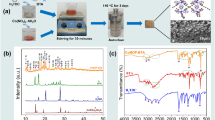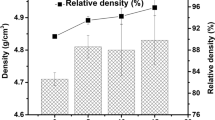Results from studies on the modification of Nb–Cr–Mo–Si–B composites with Mo chalcogenides are presented. Use of MoS2 and MoSe2 as integral parts of multicomponent oxygen-free compositions was shown to have positive effects due to the formation of highly active elemental Mo species resulting from their dissociation that determined the high heat resistance of coatings formed from them.




Similar content being viewed by others
References
V. T. Kalinin, A. S. Dudnikov, A. Ya. Kachan, et al., “Preparation of nanocrystalline compositions by controlled plasmachemical synthesis,” Vestn. Dvigatelestr., No. 1, 134 – 137 (2007).
E. N. Kablov, S. A. Muboyadzhyan, and A. N. Lutsenko, “Nanostructured ion-plasma protective and strengthening coatings for gas-turbine engine blades,” Vopr. Materialoved., No. 2, 175 – 186 (2008).
L. B. Getsov, Materials and Strength of Gas Turbine Parts [in Russian], Izdatel’skii Dom, Rybinsk, 2010, 591 pp.
E. N. Kablov, D. V. Grashchenkov, N. V. Isaeva, et al., “Perspective high-temperature ceramic composite materials,” Ross. Khim. Zh., 54(1), 20 – 24 (2010).
F. Z. Utyashev, I. A. Burlakov, V. A. Geikin, et al., “Scientific fundamentals of high-efficiency roll forming technology for axially symmetric parts of a gas-turbine engine rotor of high-temperature alloy,” Probl. Mashinostr. Nadezhnosti Mash., No. 5, 96 – 105 (2013).
A. V. Varaksin, V. A. Kostylev, V. L. Lisin, et al., “Effect of electrochemical process parameters on granulometric composition and morphology of Ti powders,” Butler. Soobshch., 37(1), 62 – 67 (2014).
A. V. Varaksin, V. A. Kostylev, V. L. Lisin, et al., “Electrochemical production of nanoscale and ultrafine powders of metals and their carbides,” Butler. Soobshch., 37(1), 76 – 83 (2014).
V. L. Lisin, V. A. Kostylev, L. I. Leont’ev, et al., “Technology for producing nanoscale and ultrafine metal powders for various purposes by an electrochemical method,” in: Physical Chemistry and Technology in Metallurgy: Collected Works Dedicated to the 60th Anniversary of IMET UrO RAN [in Russian], Yuzhno-Ural’skoe Kn. Izd., Chelyabinsk, 2015, pp. 218 – 226.
R. A. Andrievskii and A. V. Ragulya, Nanostructured Materials: Study Guide for Students of Higher Educational Institutions [in Russian], Akademiya, Moscow, 2005, 192 pp.
R. A. Andrievskii, Principles of Nanostructured Materials Science: Potential and Problems [in Russian], BINOM. Laboratoria Znanii, Moscow, 2012, 327 pp.
R. A. Andrievskii, “Nanomaterials for Extreme Conditions,” Khim. Zhizn, No. 6, 2 – 5 (2013).
R. A. Andrievskii, Metallic Nanomaterials Under Extreme Conditions: Study Guide [in Russian], Laboratoriya Znanii, Moscow, 2016, 102 pp.
G. A. Malygin, “Strength and plasticity of nanocrystalline materials and nanosized crystals,” Usp. Fiz. Nauk, 181(11), 1129 – 1156 (2011).
L. B. Zuev and V. I. Danilov, Physical Bases of Material Strength [in Russian], Intellekt, Moscow, 2013, 373 pp.
V. M. Yurov, V. Ch. Laurinas, and S. A. Guchenko, “Several physics questions on the strength of metallic nanostructures,” Fiz.-Khim. Aspekty Izuch. Klasterov, Nanostrukt. Nanomater., No. 5, 408 – 412 (2013).
A. D. Pomogailo, A. S. Rozenberg, and I. E. Uflyand, Metal Nanoparticles in Polymers [in Russian], Khimiya, Moscow, 2000, 672 pp.
V. V. Volkov, T. A. Kravchenko, and V. I. Roldugin, “Metal nanoparticles in polymeric catalytic membranes and ion-exchange systems for advanced purification of water from molecular oxygen,” Usp. Khim., 82(5), 465 – 482 (2013).
A. I. Loskutov, O. Ya. Uryupina, V. V. Vysotskii, et al., “The influence of the dispersion medium components on the structure and properties of silver and gold nanosized particles in metal-polymer nanocomposite materials,” Nanotekhnika, No. 21, 39 – 44 (2010).
K. G. Lopat’ko, V. V. Olishevskii, A. I. Marinin, et al., “Formation of a nanosized metal fraction during electric-spark treatment of granules,” Elektron. Obrab. Mater., No. 6, 80 – 85 (2013).
N. I. Steblevskaya and M. A. Medkov, “Low-temperature extraction-pyrolytic synthesis of nanosized composites based on metal oxides,” Ross. Nanotekhnol., 5(1/2), 83 – 88 (2010).
A. M. Bagamadova, V. V. Mamedov, A. Sh. Asvarov, et al., “Production of zinc-oxide nanopowder by spontaneous explosive pyrolysis of citrate complexes,” Zh. Tekh. Fiz., 82(4), 156 – 158 (2012).
V. M. Shekunova, Yu. T. Sinyapkin, I. I. Dudenkulova, et al., “Catalytic pyrolysis of light hydrocarbons in the presence of ultrafine particles formed by electrically induced explosive dispersion of metal wires,” Neftekhimiya, 53(2), 107 – 111 (2013).
A. I. Gusev and A. A. Rempel’, Nanocrystalline Materials [in Russian], Fizmatlit, Moscow, 2000, 224 pp.
S. P. Zimin and E. S. Gorlachev, Nanostructured Lead Chalcogenides, Izd. Yaroslavskogo Gos. Univ. im. P. G. Demidova, Yaroslavl, 2011, 232 pp.
E. V. Maraeva, “Production and study of nanostructured polycrystalline layers based on lead chalcogenides,” Fundam. Probl. Radioelektron. Priborostr., 14(3), 47 – 50 (2014).
V. E. Fedorov, Yu. V. Mironov, S. B. Artemkina, et al., “Dispersion of layered molybdenum and tungsten chalcogenides and production of thin films from their colloidal dispersions,” Vestn. Nats. Tekh. Univ., Khim. Khim. Tekhnol. Ekol., No. 57, 168 – 175 (2013).
L. A. Chernozatonskii and A. A. Artyukh, “Quasi-two-dimensional transition metal dichalcogenides: Structure, synthesis, properties and applications,” Usp. Fiz. Nauk, 188(1), 3 – 30 (2018).
A. Kandemir, H. Yapicioglu, A. Kinaci, et al., “Thermal transport properties of MoS2 and MoSe2 monolayers,” Nanotechnology, 27(5), 055703 – 055709 (2016).
S. V. Khashkovskii, “High-temperature synthesis of heat-resistant borosilicide coatings of compositions containing molybdenum chalcogenides,” in: Heat-resistant Functional Coatings: Proceedings of the XIXth All-Russian Convention [in Russian], Vol. 2, V. Ya. Shevchenko (ed.), Yanus, St. Petersburg, 2003, pp. 138 – 141.
V. P. Babak, V. V. Shchepetov, and S. D. Nedaiborshch, “Features of friction and wear in vacuo of detonation coatings of Cr–Si–B containing molybdenum disulfide,” Vestn. Nats. Tekh. Univ., Ser.: Mekh.-Tekh. Sist. Kompleksy, No. 17, 24 – 29 (2016).
G. S. Borisov and Yu. I. Dytnerskii, Main Processes and Apparatuses of Chemical Technology [in Russian], Al’yans, Moscow, 2010, 496 pp.
L. A. Tkachenko, A. Yu. Shaulov, and A. A. Berlin, “High-temperature protective coatings for carbon fibers,” Neorg. Mater., 48(3), 261 – 271 (2012).
D. Chiappe, E. Scalise, E. Cinquanta, et al., “Two-dimensional Si nanosheets with local hexagonal structure on a MoS2 surface,” Adv. Mater., 26(13), 2096 – 2101 (2014).
E. A. Fedorova, L. N. Maskaeva, S. S. Tulenin, et al., “Composition and morphology of chemically deposited films of Cu2Se–Ga2Se3,” Kondens. Sredy Mezhfaznye Granitsy, 14(4), 489 – 495 (2012).
S. S. Tulenin, V. F. Markov, E. A. Fedorova, et al., “Hydrochemical synthesis of metal chalcogenide films. Part 14. X-ray photoelectron spectroscopy of CuGaSe2 films produced by hydrochemical deposition,” Butler. Soobshch., 30(4), 105 – 122 (2012).
D Kong, H. Wang, J. J. Cha, et al., “Synthesis of MoS2 and MoSe2 films with vertically aligned layers,” Nano Lett., 13(3), 1341 – 1347 (2013).
S. S. Tulenin, “Hydrochemical deposition of In2S3 and In2Se3 films and chalcopyrite structures based on them,” Candidate Dissertation in Chemical Sciences, Ekaterinburg, 2015, 197 pp
D. D. Titov, Yu. F. Kargin, N. A. Popova, et al., “New composite materials based on molybdenum disilicide,” Perspekt. Mater., No. 11, 493 – 500 (2011).
D. D. Titov, A. S. Lysenkov, Y. F. Kargin, et al., “Sintering activation energy MoSi2–WSi2–Si3N4 ceramic,” in: IOP Conf. Ser.: Mater. Sci. Eng., IOP Publishing, Vol. 347, No. 1, 012024 (2018).
L. P. Efimenko, M. V. Sazonova, K. E. Pugachev, et al., “Thermal stability of MoSi2–TiB2–CrB2 composites at 900 – 1400°C,” Fiz. Khim. Stekla, 39(2), 308 – 325 (2013).
A. M. Stolin, P. M. Bazhin, M. V. Mikheev, et al., “Silicide ceramic synthesis based on molybdenum disilicide in a combustion regime under high-temperature deformation conditions,” Nov. Ogneupory, No. 6, 56 – 61 (2015).
S. N. Perevislov, A. S. Lysenkov, and S. V. Vikhman, “Effect of Si additions on the microstructure and mechanical properties of hot-pressed B4C,” Inorg. Mater., 53(4), 376 – 380 (2017).
I. A. Rumyantsev and S. N. Perevislov, “Lightweight composite cermets obtained by titanium-plating,” Refract. Ind. Ceram., 53(7), 405 – 409 (2017).
S. N. Perevislov, P. V. Shcherbak, and M. V. Tomkovich, “High density boron carbide ceramics,” Refract. Ind. Ceram., 59(1), 32 – 36 (2018).
S. N. Perevislov, P. V. Shcherbak, and M. V. Tomkovich, “Phase composition and microstructure of reaction-bonded boron-carbide materials,” Refract. Ind. Chem., 59(2), 179 – 183 (2018).
Author information
Authors and Affiliations
Corresponding author
Additional information
Translated from Novye Ogneupory, No. 1, pp. 63 – 70, February, 2020.
S. V. Khashkovsky is deceased.
Rights and permissions
About this article
Cite this article
Khashkovsky, S.V., Perevislov, S.N. Synthesis of Heat-Resistant Oxygen-Free Nb–Cr–Mo–Si–B Coatings from Compositions Modified with Refractory Group IV – Via Metal Chalcogenides. Refract Ind Ceram 61, 61–67 (2020). https://doi.org/10.1007/s11148-020-00431-1
Received:
Published:
Issue Date:
DOI: https://doi.org/10.1007/s11148-020-00431-1




